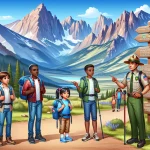Colorado has a long and vibrant Native American history spanning thousands of years. Various tribes of indigenous people have called this rugged, mountainous land home, from the Utes in the west to the Cheyennes and Arapahos in the eastern plains. These groups left an indelible mark on Colorado through their cultural traditions, spiritual beliefs, artifacts, and environmental interactions.
In This Article
Colorado offers visitors numerous opportunities to engage with this living heritage through museums, cultural events, historical sites, and local cuisine. As the state works to preserve Native languages and promote education on indigenous topics, Colorado’s Native American communities continue preserving age-old customs while making modern contributions to society.
TL;DR
- Colorado is home to several Native American tribes, like the Utes, Cheyennes, and Arapahos, with a cultural history of over 10,000 years.
- Rich heritage can be experienced through museums, cultural events, historical landmarks, and cuisine.
- Tribes keep traditions alive through language programs, educational initiatives, festivals, and community efforts.
Overview of Native American Tribes in Colorado
For over 10,000 years, Colorado has been inhabited by Native American tribes drawn by its mountains, forests, and plains. Western Colorado was dominated by the Ute tribe, comprised of seven bands, including the Muache and Capote. Central and eastern Colorado hosted tribes of the Great Plains like the Cheyenne and Arapaho, nomadic hunter-gatherers traversing the prairie. Rocky Mountain National Park was once home to the Arapaho and Ute people. These groups left behind artifacts like projectile points, pottery, and rock paintings showcasing vibrant cultures connected to nature.
Today the Colorado Commission of Indian Affairs is the official liaison between the Southern Ute Indian Tribe and the Ute Mountain Ute Tribe. The organization also facilitates communications with other indigenous nations within Colorado.
Immersing in Authentic Local Culture
Visitors can immerse themselves in Native American culture through various local experiences. Signature crafts include Ute beadwork and Cheyenne quillwork, incorporated into jewelry and moccasins. Traditional dancing and drum circles are highlights of festivals like the Southern Ute Tribe Bear Dance in southern Colorado and the March Powwow in Denver.
To taste indigenous cuisine, frybread, wojapi berry pudding, and bison meat are popular options. Staying on a reservation provides opportunities to appreciate customs around family, spirituality, and storytelling. These activities offer a window into Native American life.
History of Native American Contributions
Native tribes helped shape Colorado through their interactions with early explorers and settlers. Utes blazed the Old Spanish Trail to facilitate trade, while Cheyennes and Arapahos negotiated peace treaties opening land for development. All tribes ceded territories, reducing their land, yet retained cultural autonomy on reservations, allowing traditions to endure.
Casinos and other business enterprises now generate income and employment—modern contributions upholding sovereignty. Intertribal organizations have unified voices on issues like education, health, and the environment.
Showcasing Native Art and Artifacts
Various museums and cultural centers preserve and exhibit Native American art and artifacts in Colorado. Denver Art Museum and History Colorado Center have expansive collections, including Ute drums, Cheyenne ledger drawings, and Arapaho beaded garments. Living history museums like the Ute Indian Museum and Arapaho National Historic Site use recreated dwellings and demonstrations to showcase past lifeways.
These institutions offer glimpses into indigenous creativity and ingenuity.
Celebrating Through Festivals and Events
Annual festivals mark seasonal transitions and honor deep-rooted customs. Utes host spring and fall Bear Dances reenacting an ancient legend. Cheyennes commemorate warriors at the Northern Colorado Intertribal Powwow. Customs around courtship, storytelling, and socializing underpin these gatherings, which are accompanied by feasting. The Denver March Powwow in early spring also draws over 500 dancers competing across categories, observed by thousands. These jubilant events sustain communal bonds.
November is Native American Heritage Month, so it’s expected that you’ll find many scheduled events that provide opportunities for education and experiencing Native American culture.
Preserving Culture Through Education
Educational initiatives help sustain cultural identity by teaching Native languages and heritage. The Southern Ute Montessori Academy immerses children in Ute language acquisition. Arapaho language programs similarly work to revitalize fluency through elder mentorship. Institutions like the University of Colorado Boulder offer Native American studies exploring history and tribal sovereignty issues. These efforts reinforce knowledge across generations in dynamic ways.
Connecting With Nature and Spirituality
Colorado Native Americans revere the natural world and incorporate it into spirituality. Utes hold springs sacred, believing they harbor healing spirits. As clan symbols and mystical guides, mountains, plants, and animals like bears, eagles, and wolves feature in oral traditions.
Ceremonies like the Sun Dance ritually renew harmony between people, nature, and the spirit world. Daily activities like hunting or foraging retain spiritual significance. This interdependent relationship continues today.
Preserving Identity in Modern Communities
On reservations, close-knit communities maintain Native identity through proactive efforts. Cultural committees organize language programs and ceremonies guided by elders. Powwows and festivals bring families together.
Tribal colleges, museums, and heritage centers celebrate history and nurture young talent to lead new generations. Casinos and tourism enterprises also affirm sovereignty while boosting income. Communities thus balance progress and tradition.
FAQ
What are examples of Native American languages spoken in Colorado?
The Ute, Cheyenne, and Arapaho tribes speak languages belonging to the Uto-Aztecan, Algonquian, and Algic language families, respectively. These include different regional dialects like Northern Ute and Southern Ute.
Where are some Native American cultural events held in Colorado?
Major powwows are held in Denver and on tribal lands like the Southern Ute and Ute Mountain reservations. Other cultural events occur at heritage centers and museums statewide.
What Native American groups originally lived in Colorado?
Archaeological evidence shows ancestral Puebloan, Fremont, Apache and other groups inhabited Colorado before the current tribes. Navajos and Hopis also have historical ties to the region.
How can visitors respectfully experience Native American culture?
Visitors should educate themselves on customs, support Native businesses and events, appreciate cultural displays in their historical context, and listen to tribal voices on issues impacting their communities.
What Native American symbols from Colorado have broader significance?
Meanings behind clan symbols like the Ute bear, Cheyenne horse, and Arapaho thunderbird symbolize broader concepts around strength, mobility, and divine power.






